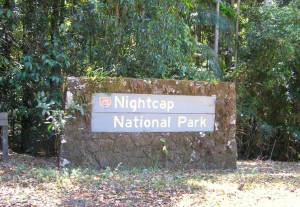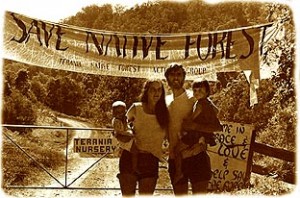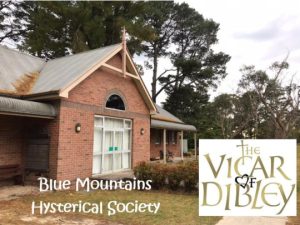1979 Terania Creek direct action saved Gondwana
Thursday, January 23rd, 2014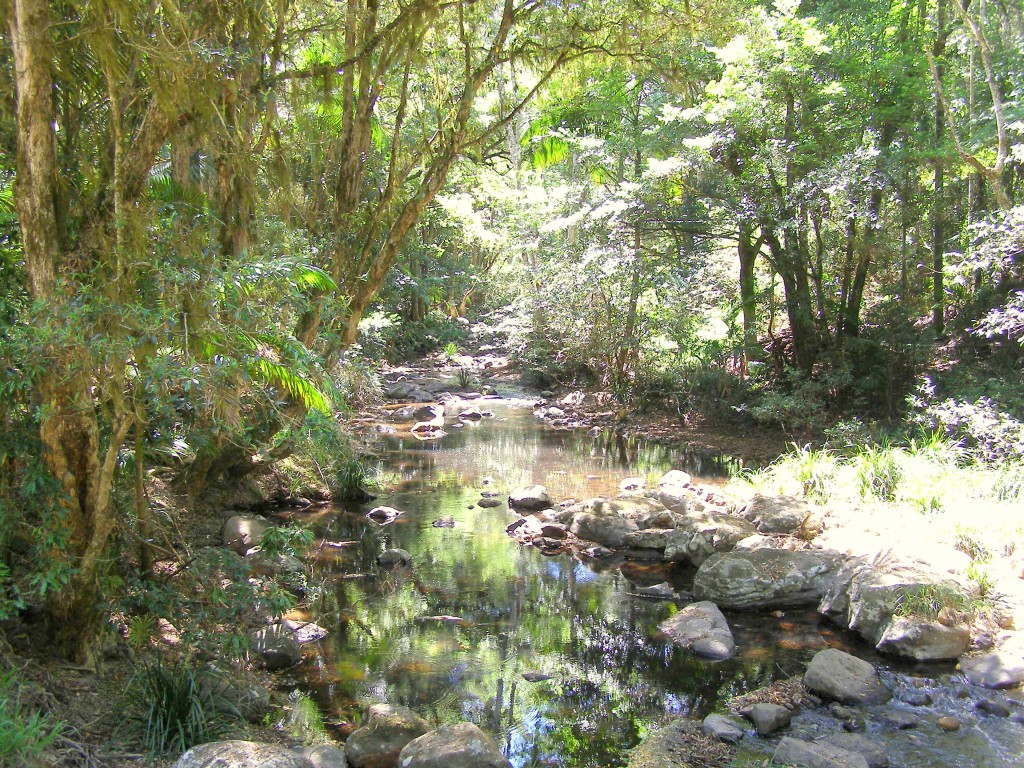 Terania Creek
Toward Nightcap National Park, part of the Gondwana Rainforests of Australia World Heritage Area,
Northern Rivers Region, New South Wales, Australia.
‘Terania‘ is thought to be a local Aboriginal (Bundjalung) name meaning ‘place of frogs’.
[Click image to enlarge, photo by Editor 20131023, © under ^Creative Commons]
Terania Creek
Toward Nightcap National Park, part of the Gondwana Rainforests of Australia World Heritage Area,
Northern Rivers Region, New South Wales, Australia.
‘Terania‘ is thought to be a local Aboriginal (Bundjalung) name meaning ‘place of frogs’.
[Click image to enlarge, photo by Editor 20131023, © under ^Creative Commons]
.
Today’s National Parks and Wildlife Service website on Nightcap National Park reads as follows:
.
<<Nightcap National Park, part of the Gondwana Rainforests of Australia World Heritage Area, is a dramatically beautiful park full of ancient rainforests, magical waterways and spectacular views. The lush rainforest provides a home for the newly discovered nightcap oak as well as a number of threatened animal species, including Albert’s lyrebird and Fleay’s barred frog which takes shelter under leaf litter and makes an ‘ok-okok-ok-ok’ after rain.
With easy access from Lismore and Nimbin, you can enjoy a picnic, bushwalk or overnight camping trip amid the park’s escarpments, waterfalls and crystal clear creeks and enjoy incredible views of the 20 million year-old Wollumbin shield volcano. >>
[Source: National Parks and Wildlife Service, NSW Government, ^http://www.nationalparks.nsw.gov.au/nightcap-national-park].
.
However, were it not for a handful of dedicated environmental activists protesting on site in the late 1970s, the Nightcap National Park would not exist.
Its magnificent rainforest ecology would be have been decimated by industrial logging, then scorched-earthed and the entire landscape converted to pasture, resembling much of what has occurred throughout the Northern Rivers Region.
In the late 1970s, the government sent in the police to protect the loggers, not the rainforest.
<< Terania Creek, located in the Nightcap Range in northern New South Wales was the site of the first major forest blockade in Australian history. Over 200 protesters halted logging of the rainforest, through non-violent direct action. In 1982, a similar protest occurred at Mount Nadi on the other side of the Nightcap Range. In 1982, the Premier, Neville Wran, declared a moratorium on the logging of rainforests in New South Wales. Today, the Nightcap National Park incorporates Mount Nadi, Griers Scrub and Terania Creek. >>
[Source: ‘Australian environmental activism Timeline’, Board of Studies NSW, New South Wales Government, ^http://www.teachingheritage.nsw.edu.au/section03/timeenviron.php].
So when one visits the National Parks offices staffed by government employees, reflect on the fact that the offices and staff exist not because of government leadership, but because of the selfless will of environmental activists prepared to go to jail to save these invaluable and increasingly rare rainforests.
.
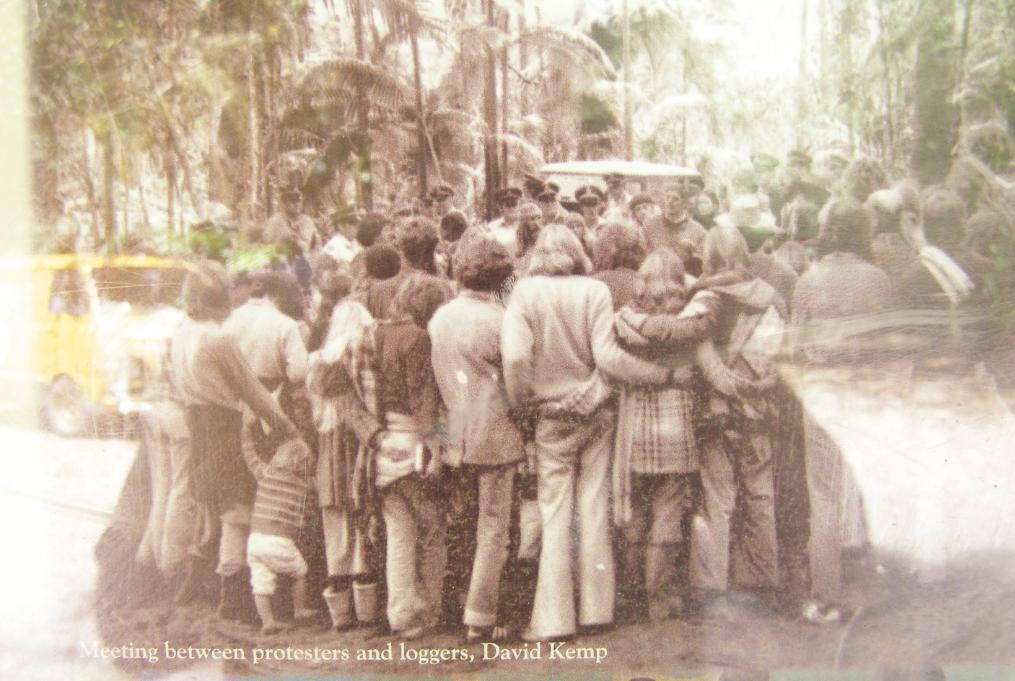 Community direct action protest against logging at Terania Creek in 1979
This black and white photo by David Kemp (1979) is part of a faded pictorial history montage behind glass in a National Parks visitor noticeboard located at Protesters Falls car park, alongside Terania Creek. The image of the original photo has fault in that it includes reflection from the glass showing a yellow van at the car park, not in 1979 but in 2013. We happily walked along the board walk to Protesters Falls, passing by we assume the van’s owner happily bent backwards meditating on a large beach ball within the shaded tranquillity of the very tall rainforest. Unawares, he has inspired the writing of this article.
[Click image to enlarge, photo by Editor 20131023, © under ^Creative Commons]
Community direct action protest against logging at Terania Creek in 1979
This black and white photo by David Kemp (1979) is part of a faded pictorial history montage behind glass in a National Parks visitor noticeboard located at Protesters Falls car park, alongside Terania Creek. The image of the original photo has fault in that it includes reflection from the glass showing a yellow van at the car park, not in 1979 but in 2013. We happily walked along the board walk to Protesters Falls, passing by we assume the van’s owner happily bent backwards meditating on a large beach ball within the shaded tranquillity of the very tall rainforest. Unawares, he has inspired the writing of this article.
[Click image to enlarge, photo by Editor 20131023, © under ^Creative Commons]
.
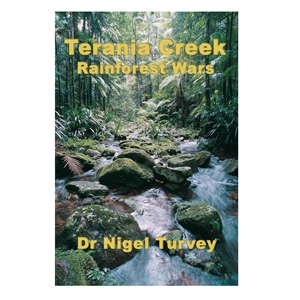 Find Out More: ^http://nigelturvey.com/page1001.aspx
Find Out More: ^http://nigelturvey.com/page1001.aspx.
<< The conflict began in 1979 over a small patch of rainforest in Terania Creek, in north-eastern New South Wales. It was Australia’s first forest protest, and it was ahead of its time both globally and environmentally. The conflict spread across New South Wales and pushed forestry issues to the forefront of politics. Protesters from Terania Creek went on to similar conflicts in the Franklin River in Tasmania, the Daintree rainforests in Queensland, and Errinundra Plateau in Victoria.
Inevitably, people on both sides of the conflict suffered. Protesters were vilified as hippies and dole bludgers, and their lifestyles and homes were targeted. Workers in the forest and sawmills were labelled as loggers and vandals, and their families and businesses were damaged. >>
.
[Quoted extract from the preface in the non-fiction book, ‘Terania Creek: Rainforest Wars‘, (2006) by author Dr Nigel Turvey, published by Glass House Books, Brisbane. A part of what has now become Australian history that needed to be told, a reflective generation later]..
The power of ‘Direct Action’ to turn government and public opinion
.
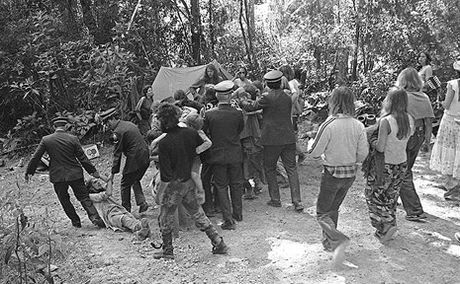 Local resident Neil Pike (left) being dragged away from the protest site by police down Mackay’s Road 17th August 1979
[© Photo by Darcy McFadden, The Northern Star (newspaper) photographer].
Local resident Neil Pike (left) being dragged away from the protest site by police down Mackay’s Road 17th August 1979
[© Photo by Darcy McFadden, The Northern Star (newspaper) photographer].
.
Nearby Mt Nardi resident and musician Neil Pike:
<< “Some time during 1975 there were signs up around Nimbin about the logging plans for Terania Creek. By 1979, when the loggers were due to arrive in the valley, a lot of discussion was going on at The Channon Markets.”
.
Channon Markets Sunday, August 12, 1979:
“There was a big rally and the protest organisers asked if they could use my PA. They called for people to blockade and a lot of people went straight from the market to the Nicholson property which bordered the rainforest. We camped there for more than a month. Everyone was up at the bulldozer, blocking its way into the rainforest – there were cops everywhere.
“A cop told one of the protest organisers to get everyone to move down the track but I stayed where I was as most people moved off. That’s when the two cops grabbed me and dragged me down the track to the paddy wagon – it was at least a few minutes and they fractured two of my vertebrae.”
The blockade was the catalyst for the NSW Government to gazette the remaining rainforest in the state, including Terania Creek, as National Park. >>
.
[Source: ‘Direct action saved Terania’, article by Georgina Bible, 20090815, The Northern Star newspaper, Norther Rivers Region, ^http://www.northernstar.com.au/news/direct-action-saved-terania/296606/].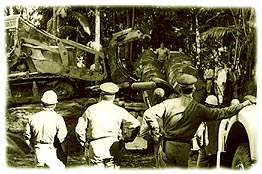
.
One of Australia’s most fiercely fought environmental battles
.
<< “Urban refugees Hugh and Nan Nicholson moved onto a property at Terania Creek in northern NSW 30 years ago. They were hoping to escape the rat race and live a self-sufficient lifestyle, but discovered that the forest surrounding their property was earmarked for extensive logging.
So began one of Australia’s most fiercely fought environmental battles, the 1979-1982 Rainforest Wars. The wars ended with the formation of Nightcap National Park, which was World Heritage-listed for good measure in 1989.
Author Nigel Turvey, a former forester and environmental scientist, stands (respectfully) on the shoulders of those who were there, using their words and pictures to give us an insightful overview of an emotionally charged environmental campaign from beginning to end; he even sets it firmly in its time with references to other newsworthy happenings such as the Azaria Chamberlain case and the Vietnam War.
One of the unexpected bonuses of this book is that it offers an inside look at the forestry profession and how it fell from grace (in the public’s eyes) during this campaign, never to recover again.
‘Terania Creek: Rainforest Wars‘ is a real page-turner and a must-read for anyone interested in conflicts in Australia’s natural places.” >>
.
[Source: Review by Louise Southerden, ^http://www.greenlifestylemag.com.au/reviews/516/terania-creek-rainforest-wars].
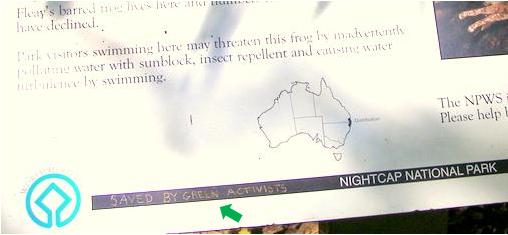 The National Parks Sign with appropriate graffiti-etched message.
A poignant reminder that Nightcap National Park came about only because of Community Direct Action.
[Photo by Editor 20131023 in Nightcap NationalPark, © under ^Creative Commons]
The National Parks Sign with appropriate graffiti-etched message.
A poignant reminder that Nightcap National Park came about only because of Community Direct Action.
[Photo by Editor 20131023 in Nightcap NationalPark, © under ^Creative Commons]
.
‘Terania Creek: Rainforest Wars’ – extracts from Chapter 1
.
[Ed: This book is a must read for any environmentalist/conservationist with a respect for the pioneers of environmental direct action and for any student of the Conservation Movement]
.
<< On the easternmost part of Australia, it survived the drifting continent’s climatic shifts and a hundred and fifty years of timber-getting. In 1979 some claimed it was the last unlogged rainforest and should be saved, but for foresters and saw-millers it was the last rainforest they would plan to log. The dispute over logging flared into the Rainforest War across New South Wales.
Today forest protests are part of Australia’s political landscape, but Terania Creek was the first.
This story is about the people from both sides who fought over the rainforest, but the enduring player in the story is the rainforest itself.
Enter the forest and you find mottled tree trunks soaring to crowns high in the canopy, supported by elegantly curved or plank-like buttresses, taller than a man, smaller trees with no buttresses at all, and trees with tumbling bifurcating trunks that grow downwards to the ground, encircling and strangling the small trees that give them support. You crouch to avoid the tangle of creepers as thick as a forearm, and the vines, some armed with hooks, which loop between the trees.>>
.
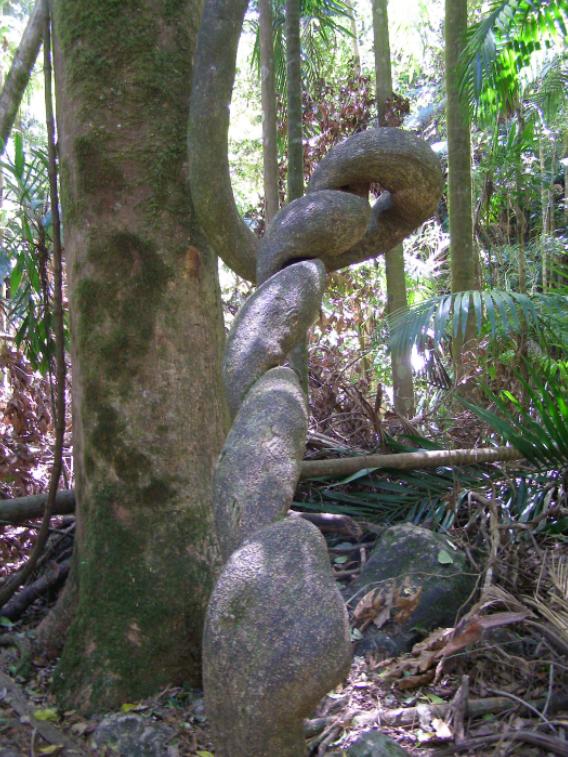 “tangle of creepers as thick as a forearm”
[Photo by Editor 20131023 in Nightcap National Park, © under ^Creative Commons]
“tangle of creepers as thick as a forearm”
[Photo by Editor 20131023 in Nightcap National Park, © under ^Creative Commons]
.
<< You stand under tree ferns several metres tall, with their fragile fronds and insubstantial stems protected by the high humidity and dense shade under the forest’s multiple canopy layers. And in a quiet moment you hear the startling stereophonic calls of a whip-bird and its mate. >>
.
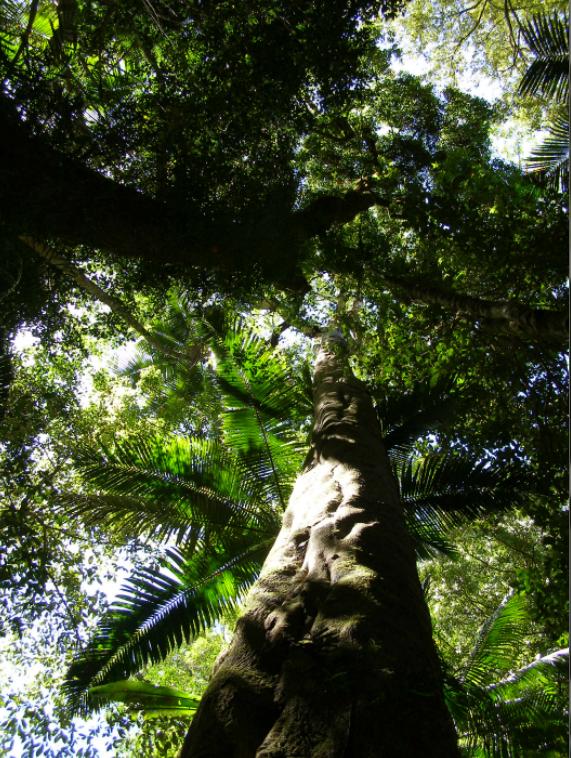 Yellow carabeen (Sloanea woollsii)
growing to 55 metres and vital to the rainforest canopy
[Photo by Editor 20131023 in Nightcap National Park, © under ^Creative Commons]
Yellow carabeen (Sloanea woollsii)
growing to 55 metres and vital to the rainforest canopy
[Photo by Editor 20131023 in Nightcap National Park, © under ^Creative Commons]
.
<< In the early part of the twentieth century, the rainforests and drier eucalypt forests of the caldera (volcanic basin) were logged by sawmills that grew up around the ranges, providing timber for new rural industries and housing for the expanding population of the young State of New South Wales.
Soft workable timbers were harvested from remote rainforest refuges, like Terania Creek, in uncontrolled logging to supply the war effort during World War II. Bush crews returned to log the southern part of Terania Creek in the 1950s and again in 1968, but the northern part of the basin under the overhanging cliffs remained untouched. >>
.
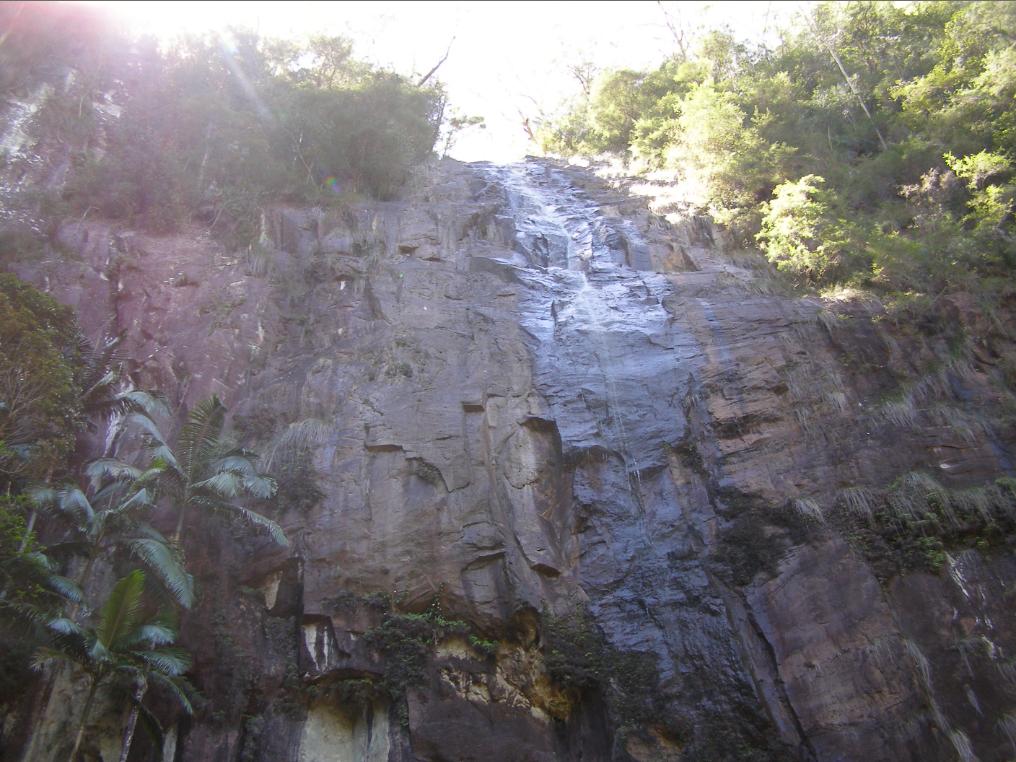 Protesters Falls, Terania Creek
The overhanging cliffs so described by Dr Turvey, appropriately since named in honour of those who protested and saved the rainforest from logging
[Photo by Editor 20131023 in Nightcap National Park, © under ^Creative Commons]
Protesters Falls, Terania Creek
The overhanging cliffs so described by Dr Turvey, appropriately since named in honour of those who protested and saved the rainforest from logging
[Photo by Editor 20131023 in Nightcap National Park, © under ^Creative Commons]
.
<< More than two hundred years of European activity along the eastern seaboard reduced Australia’s rainforests by three quarters of their pre-1770 cover, through clearing for agriculture, uncontrolled logging, and conversion to plantations (and dairy pasture). The rainforests, which covered just 1% of Australia two hundred years ago, now cover just one quarter of one percent of the Australian landmass.
The dairy industry that had flourished on the cleared slopes of the caldera was in decline by the 1970s, and young settlers moved on to the cheap farmland. >>
.
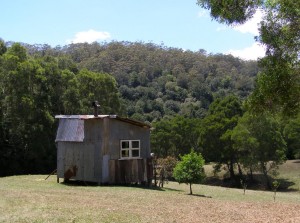 [Photo by Editor 20131026, © under ^Creative Commons]
[Photo by Editor 20131026, © under ^Creative Commons]
.
<< In September 1973 Hugh and Nan Nicholson, two urban refugees looking for a self-sufficient lifestyle, found Terania Creek. They drove north from the hamlet of The Channon on a rough dirt road through steepening hills that forced the road to wind tightly around and through the creek on the valley floor.
.
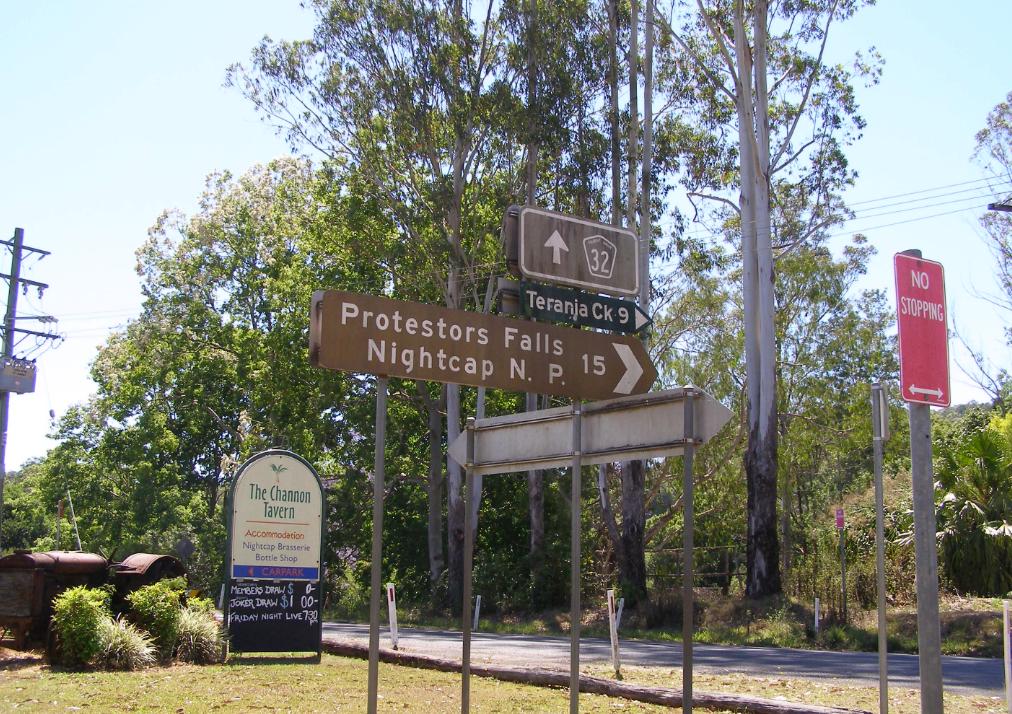 The Channon (hamlet), turnoff to Terania Creek
[Click image to enlarge, photo by Editor 20131023]
The Channon (hamlet), turnoff to Terania Creek
[Click image to enlarge, photo by Editor 20131023]
.
<< Just before the valley sides closed in completely they found a small patch of cleared land running a short distance upslope from the creek flats. It was the last cleared land at the end of the road, a degraded dairy farm losing ground to encroaching weeds (typically Lantana). On the eastern boundary, across the creek, was the rainforest of Whian Whian State Forest, and on the northern boundary was Goonimbar State Forest with its tall, moist rainforest and palm communities. The forests were held in the basin of Terania Creek, ringed with cliffs below the backdrop of the Nightcap Range. >>
.
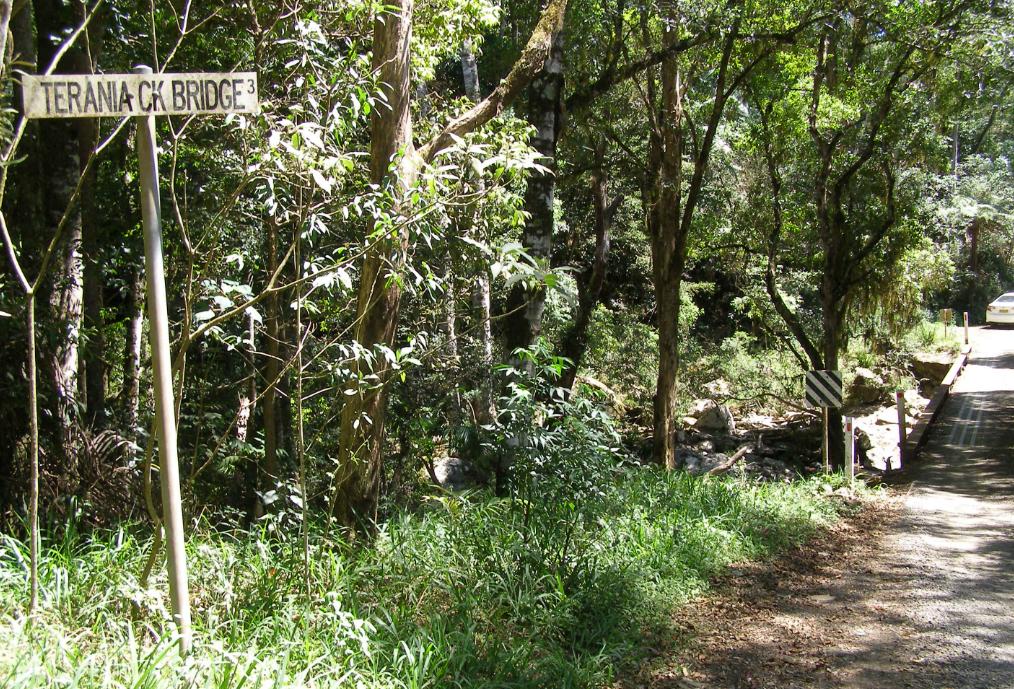 The road following up and crossing over Terania Creek multiple times.
Photo by Editor 20131023, © under ^Creative Commons]
The road following up and crossing over Terania Creek multiple times.
Photo by Editor 20131023, © under ^Creative Commons]
.
<< It fitted all their criteria: it was a scene of exceptional beauty, an inspirational landscape, a spiritual refuge.>>
.
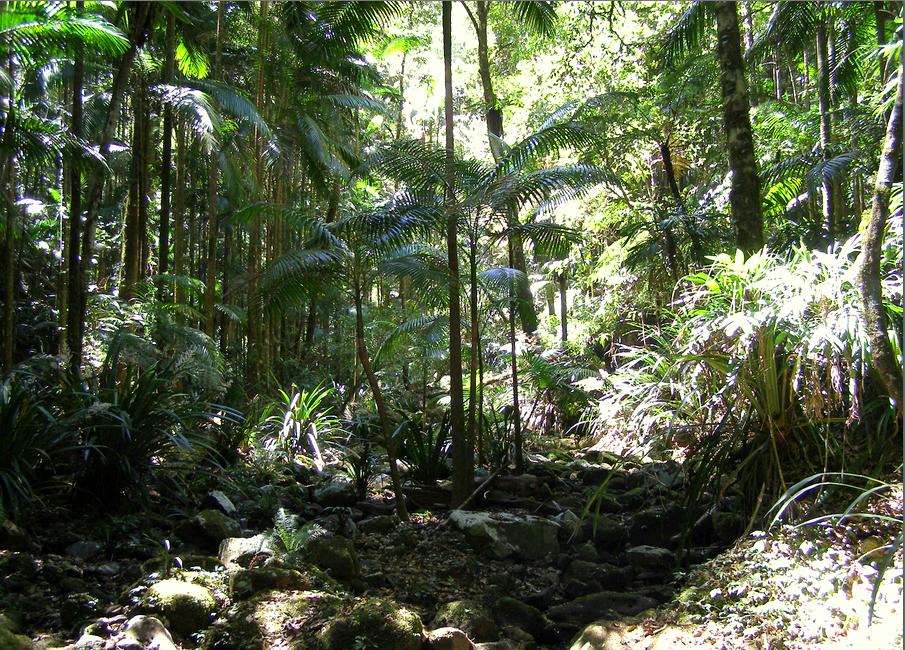 Terania Creek now protected inside the Nightcap National Park
[Photo by Editor 20131023, © under ^Creative Commons]
Terania Creek now protected inside the Nightcap National Park
[Photo by Editor 20131023, © under ^Creative Commons]
.
<<Then a war broke out in this most peaceful landscape – the Rainforest War. It started in 1979 with a battle over the rainforests of Terania Creek and spread to rainforests across the State of New South Wales. On one side were the young settlers making their homes around the caldera. On the other side were the Forestry Commission of New South Wales and the sawmills it licensed.
The new settlers were bent on protecting the forests; they felt a spiritual relationship with the rainforests, were in awe on the ancient life-forms and felt duty-bound to protect them. The Forestry Commission, in contrast, managed extensive forest regions on long cycles of cutting and regeneration according to silvicultural principles of forest management. Geographically, its focus was regional and broad, whereas that of the protesters, initially was local and narrow; its intervention was based on science (agroforestry) and economics while that of the protesters was based on conservation (ecological science which then not been formalised) and spirituality.>>
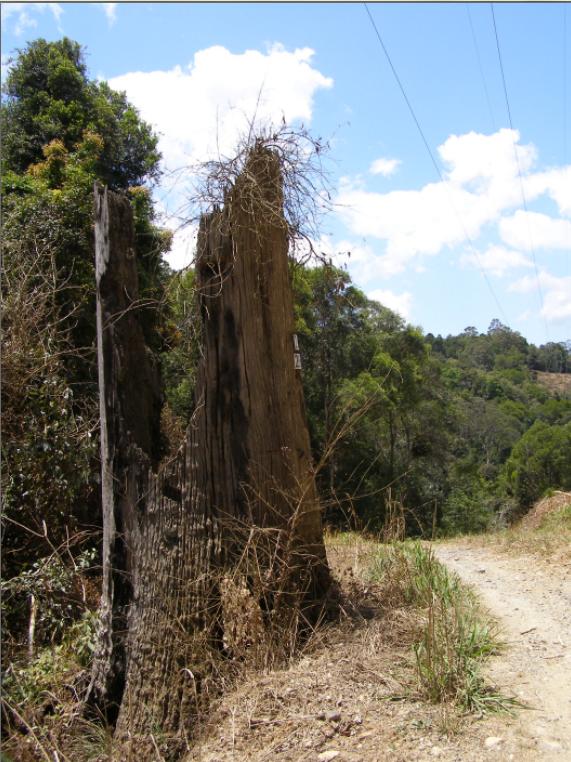 Lest We Forget
What could have been at Terania Creek, and what is left of much of Gondwana in Australia
[Photo by Editor 20131026, © under ^Creative Commons]
Lest We Forget
What could have been at Terania Creek, and what is left of much of Gondwana in Australia
[Photo by Editor 20131026, © under ^Creative Commons]
.
<< The events that followed make up the story of The Rainforest War…But the central character of the story is the rainforest of Terania Creek, claimed by protesters as the last unlogged rainforest. Its ancient genetic lineage of buttressed trunks, soft leaves, colourful flowers and fleshy fruits appeared vulnerable and stimulated a primitive instinct in those who entered it. Like a newborn infant, the marvel of its existence inspired its own protection. It is a spiritual landscape – the living archaeology of Gondwana. >>
.
[Source: ‘Terania Creek: Rainforest Wars‘, (2006) by author Dr Nigel Turvey, published by Glass House Books, Brisbane, ^http://nigelturvey.com/page1001.aspx].
The joys of trouble-making on a grand scale!
.
<< Helicopters landed in the paddocks, police cars parked all over our precious grass, the campers kept expanding their area. All along Hugh and I had feared defeat and the loss of that exquisite forest. Now we feared loss of control of our lives. And we weren’t even getting into the forest to do the heroic stuff with all the other activists. We were pinned to the cabin with the phone stuck on an ear, sitting in strategy meetings while trying to remember where the kids were, or hunting for vital but constantly disappearing papers.
But we loved it too. The joys of trouble-making on a grand scale! The media whirlwind! The politicians suddenly ringing us! The euphoria of watching so many different skills miraculously dovetailing for an inspired purpose! The discovery of so many fascinating and resourceful people!
And on top of all that, after four weeks of intensity, we won. It was hard to believe. Was it the daily road blocks or the protestors up trees that did it? Was it the cut-up logs? That was bad press and everyone was appalled but it stopped the trees being felled wholesale. Was it brilliant, or just lucky, media manipulation? Was it the penetrating and relentless phone calls by Bren Claridge to Premier Wran’s office? Was it the lack of trespass laws which would have kept us out of the forest? Was it simply a state government leaving all the pawns to fight it out and point to the safe jumping side? Was the time just right to save rainforest or did we help to make the time happen?
Community cohesion thrives on tackling big issues together. And there are huge challenges confronting us: the local impact of climate change; the Dunoon Dam; the inevitable attack on forests thought saved for ever; an increasing regional population that also expects more per person in resources; the breath-taking irrationality of the belief that growth without limits is even possible let alone desirable.
People still come up to us in the street and say “I was at Terania Creek and it changed the direction of my life!” It sounds so corny now but it did feel like a coming-of-age for all of us, the new-age interlopers, even if it wasn’t appreciated by the “real” locals. Our ideal of self-sufficient living had turned out to be insufficient until it had acknowledged and defended the landscape in which it was embedded.
Finally, if nothing else, the wrestle for Terania Creek finally put us in touch with the original custodians, the people who fought for the land first and were massacred for it, in one of the worst killing fields in the entire country. We realised that fighting for your own backyard is a long-standing and deeply honourable activity. If everyone genuinely safeguarded their own patch most environmental problems would evaporate. And so would many social problems, since it is connectedness with its people and its history which enables little communities like ours to love themselves.
I don’t know but I would do it all again. In fact, as a community we need to do it all again. >>
.
[Source: ‘Saving Terania: Nan Nicholson’s personal perspective on the Terania blockade’, Terania EnviroAction Network, ^http://rainbowregion.com.au/environment/index.php?option=com_content&view=article&id=73:saving-terania&catid=41:my-word&Itemid=98].
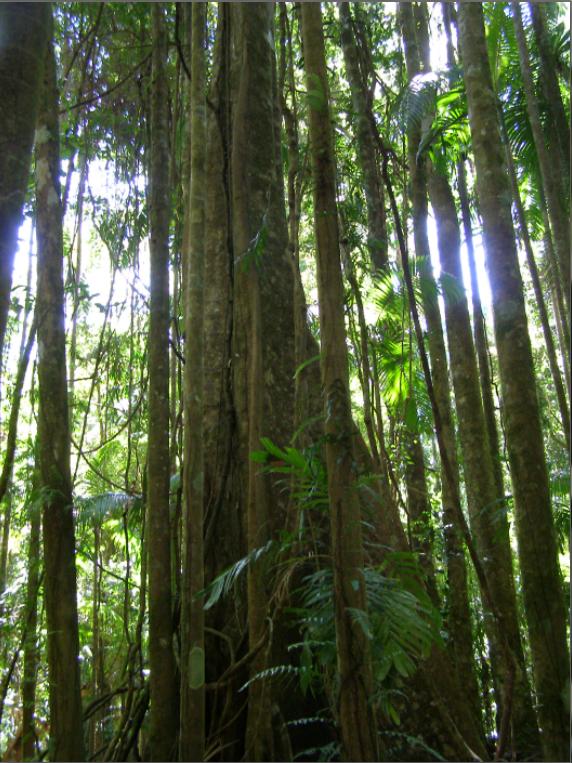 [Photo by Editor 20131023 in Nightcap National Park, © under ^Creative Commons]
[Photo by Editor 20131023 in Nightcap National Park, © under ^Creative Commons]
.
Further Reading
.
[1] ‘Terania Creek: Rainforest Wars‘, (2006) by author Dr Nigel Turvey, published by Glass House Books, Brisbane, ^http://nigelturvey.com/page1001.aspx]
.
[2] ‘Saving Terania: Nan Nicholson’s personal perspective on the Terania Blockade‘, Terania EnviroAction Network, ^http://rainbowregion.com.au/environment/index.php?option=com_content&view=article&id=73:saving-terania&catid=41:my-word&Itemid=98]
.
[3] ‘Terania Creek Diary‘, ^http://www.rainforestinfo.org.au/terania/diary.htm
.
[4] ‘May The Circle Be Unbroken‘, by Dudley Leggett, Terania Creek Action, 1979, ^http://www.rainforestinfo.org.au/terania/circle.htm
.
<< “The protest against the logging in Terania Creek Basin has been an occurrence of great social significance and for those present a spiritual experience unprecedented in their lifetime.
The spirit of caring and sharing that ebbed and flowed throughout the four week long camp of resistance was the strongest evidence that any had encountered of what was repeatedly described as tribalism but which might more easily be described as brotherhood. Perhaps it was the nature of the trees and their timeless passive servitude to man which evoked the deep inner feelings of a holy cause in their protection. Or was it the awareness of service to all mankind and the planets ecosystem that was being lived out, which allowed each individual to rise above his normal petty personal cravings and attachments…
How was this accomplished? Through the implementation of practices which re-enforced our belief in the good will of the people, the sacrifice of personal ego to guidance by the group mind. Without the circle meetings, wherein all information and feelings were exchanged and decisions made, none of this would have been possible. “May the circle be unbroken” became our deepest hymn. Through the centring of the group in the linking of the circle, the group mind was evoked and, miraculously at times, consensus was achieved. We all undertook to respect that consensus, which gave us a bewildering and potent presence in the heat of confrontation with a structured, hierarchical, but rigid and confused opponent.
And in this way we won each day and the argument to boot, demonstrating to even our amazement the power of clarity, love and peacefulness over ignorance, insensitivity and brute force.
But much more than this did we win. For what we learned about ourselves and our fellow travellers on this rainbow coloured spaceship will sustain and promote our efforts, which we will surely now give in order to bring into being a more healthy and healing lifestyle. And thus our place of power among the species here will no longer be abused but will at last be honoured.” >>
.
[5] ‘Australia’s First Forestry Blockade‘, A Question of Balance (website), ^http://www.aqob.com.au/details.php?p_id=462
‘Presented by Ruby Vincent, “A Question of Balance” is a grassroots environmental (website-based) show that is aimed at the general community to show that we can do things to improve our environment and STILL maintain an enjoyable standard of living. We do deal with important issues but attempt to avoid the doom and gloom ‘inevitable’ approach since the average person simply tunes out and there is no point in just preaching to the committed environmental activists.’
 Click icon to play interview with William Lines about the battle for Terania Creek
Click icon to play interview with William Lines about the battle for Terania Creek
.
[6] ‘Patriots: Defending Australia’s Natural Heritage 1946-2004‘, (book), by William John Lines, UQP, ^http://www.uqp.uq.edu.au/Book.aspx/784/Patriots-%20Defending%20Australia
.
[7] ‘Remembering the battle at Terania Creek‘, 20090717, The Northern Star (a newspaper of the Northern Rivers Region), ^http://www.northernstar.com.au/news/remembering-the-battle-at-terania-creek/275633/]
.
[8] ‘Give Trees a Chance: The Story of Terania Creek (1980)‘, ^http://aso.gov.au/titles/documentaries/give-trees-chance/clip3/#
‘Actor Jack Thompson wraps up the documentary, summarising the achievements of the Terania Creek protesters and delivering an impassioned plea to stop the destruction of rainforests.’
.
[9] ‘About Terania Rainforest Publishing and Hugh & Nan Nicholson‘, Rainforest Publishing, ^http://www.rainforestpublishing.com.au/index.php?href=about&dir=editable_pages&ext=html
.
[10] ‘Protesters and Forestry reach new agreement‘, September 2013, Echonetdaily, Byron Bay,^http://www.echo.net.au/2013/09/protesters-and-nsw-forestry-set-to-sign-agreement/
.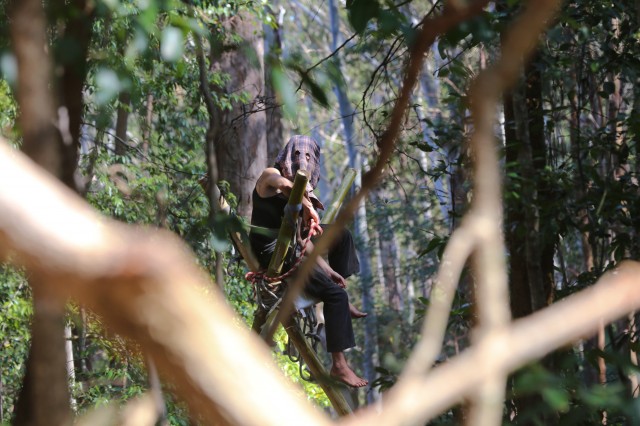 2013: Protester on a bamboo tripod on private land being logged at Whian Whian, near Terania Creek
Photo Jeff Dawson
2013: Protester on a bamboo tripod on private land being logged at Whian Whian, near Terania Creek
Photo Jeff Dawson
